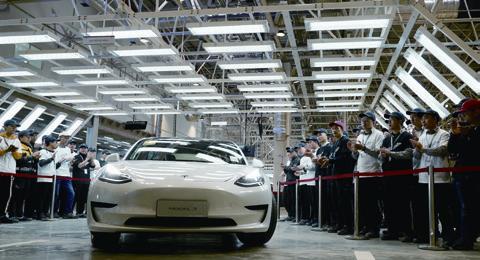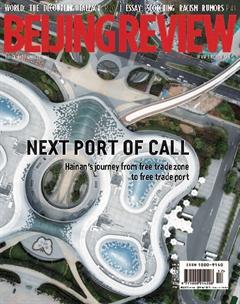Tap the New Potential
By Michael Zakkour

During this time of global pandemic and human suffering, economic hardship and uncertainty about the future is a growing and worrying trend. The calls from countries around the world to disengage and decouple from each other on trade, manufacturing, technology and commerce have been increasing. Not only is this a dangerous and fa- tally fl awed way of thinking about and acting on the future, but also would produce aftershocks that, in the parlance of the day, are an example of “the cure being worse than the disease.”
The best era
We can start thinking with some numbers.
Fifty years. Thirty-Five Years. Two. Ten years.
50—The period in which the globalization of trade and commerce and the global economy has evolved, resulting in a completely interconnected web of nations, companies, supply chains and technologies responsible for making-moving-selling-buying virtually everything.
35—The number of years that China has played a key role in the globalization of trade and commerce and the resulting creation of wealth and jobs inside and outside of China.
2—The two largest economies in the world: the U.S. and China. They are linked so closely that a decoupling would likely cripple them and the rest of the worlds economy.
10—The number of years it took for e-commerce to flower globally, for digital commerce to emerge and the New Retail/ new consumption/cross-border commerce world to develop.
Now imagine what might happen if the world were to try and hit the reverse button on all these realities, on all these timelines.
The thinking is that somehow the world, with some bold moves in trade and commerce, will go back to the way they were in the 1960s, or the 1980s, or the 2000s.
Never mind the fact that the world doesnt have a “reverse” button to take things back to the status quo of previous decades, there is no reverse button that will take things back to the way they were in 2019. Not to mention this desire to revert carries with it the assumption that the world was a richer, simpler, healthier and more equitable place in the 1960s or the 1980s.
In almost every imaginable and measurable way, the world is a better place than it was in the 1960s, 1980s and 2000s.
Prior to the outbreak of the novel coronavirus disease (COVID-19):
There were fewer people living in poverty than at any time in history.
Life-enhancing technology progressed at a faster rate than any time in history.
More people could buy more things, from more places, for less money than anytime in history.
There are fewer wars and less violence.
People are living longer, healthier lives.
The only category in which the world is worse off than it was 60, 40, 20 years ago is the environment. The price of cheaper goods, of increased global wealth and health has been a degradation of our air, water and soil, all shared resources on a single planet.
One must wonder, is it worth going back to a world where none of the above is true in pursuit of the fantasy that globalization can be undone, and that isolationism will be the panacea to problems both real and imagined?
Unrealistic idea
The proposed first step to a reset is a world where countries bring most of the manufacturing back onto their home shores.
As COVID-19 wrecked supply chains worldwide, the Japanese Government recently announced that they would make available 220 billion yen ($2 billion) in direct loans to companies who move their manufacturing back to Japan from China and another 23 billion yen ($210 million) for companies who move their production from China to another country.
That prompted U.S. National Economic Council Director Larry Kudlow to suggest that the U.S. “should pay the moving costs” of every U.S. company that wants to leave China behind. He went on to elaborate, “I would say, 100-percent immediate expensing across the board for plant, equipment, intellectual prop- erty, structures, renovations... In other words, if we had 100-percent immediate expensing, we would literally—literally pay the moving costs of American companies.”
However, there are numerous problems with their imaginary scenario.
No matter how many loans are given by governments, it is hard to imagine a scenario where companies operations, sales and supply chains would not be so disrupted by a sudden shift that it would put profi tability years away. And this in an environment where many companies are teetering on the edge of insolvency.
It does not resolve the issues of raw material and component supply chains. Shifting the locale of final assembly does not adequately address the issue.
This scenario also does not account for the fact that companies manufacture large quantities of goods in China and other low-cost countries to specifi cally sell those products in those markets.
This model also does not take into consideration the huge capital expenses required by companies to shift back to home shore production. Most companies from the U.S., Japan and Europe who manufacture in China, Southeast Asia and other developing countries do not own and operate their own factories. That is the basis of contract manufacturing.
To bring all of this back onshore would mean building new factories and new supply chains, as well as training workers. They will spend years to develop fully functioning, expert leader-led and expert worker-driven profi table operations.
These factors are why businesses in the U.S., Europe, China and the rest of the world did not want or like the tariff-driven trade war of the last two years.
These factors are also why during two years of trade war, most of the manufacturing has not moved. Many people were urging a move from China to Viet Nam, Thailand, Bangladesh, India and several African nations, but very few moves were made because these countries lack ports, railroads, highways, populations and experience to absorb any signifi cant portion of Chinas output capacity.
New catalyst
None of this is to say that rethinking, rebalancing and reshoring is not warranted. It would be naive and foolish to think that all countries, including China and the U.S., have no need to reallocate resources and capital to determine what manufacturing is to be moved home, or to new shores for national interests, security, vital needs and commercial realities.
That process was already underway during the last two years pre-COVID-19.
I dont claim to have solutions to all the complex problems the world is facing now. I dont claim to know what the right mix for manufacturing locales is. I dont claim to have a roadmap for how each country should proceed. But what I do feel strongly about is that the 50 years of globalization, 35 years of Chinese integration in the world economy, the interconnected nature of the worlds two largest economies and 10 years of technology-driven commercial norms cant be reversed or reengineered by global decoupling.
Rather, I think that all companies, no matter where they were founded, what they make or do, must do what I have advocated for many years. That is, to rethink their entire make it-move it-sell it-buy it strategies and operation for the world that is, not the world that once was or the one that only lives in a fantasy.
We are a globalized, technology-driven and prosperous planet. We can build on that. The COVID-19 crisis has damaged us all, people and companies alike, in one way or another. If we all focus on how the 5 NEW—New Retail, new consumption, new technology, new finance, and new supply chain—can be the catalyst for improvement and adjustment and long-term shared prosperity, rather than all or nothing, zero-sum focused blunt-force policies, then I do believe we can do better than going back to“the way it was” and go to places we have never been before.

